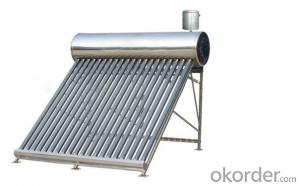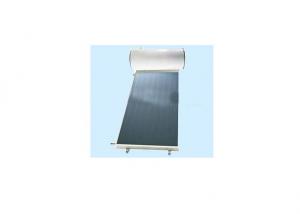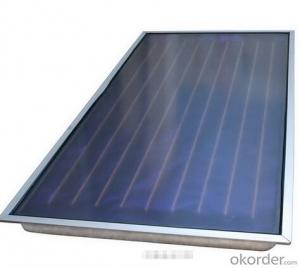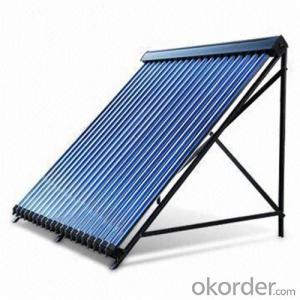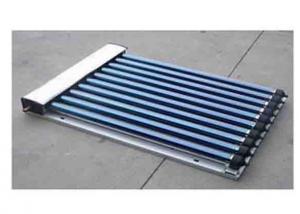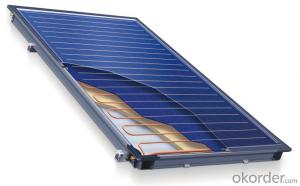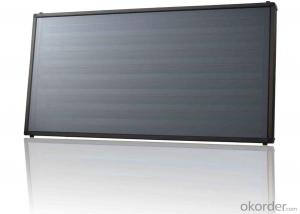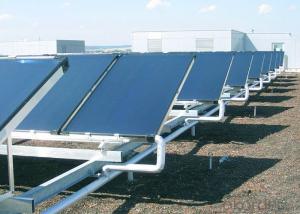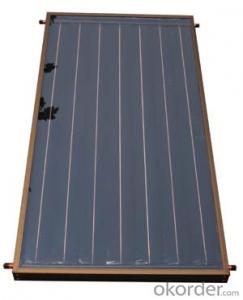Non-Pressurized Heat Pipe with Copper Solar Water Heater System
- Loading Port:
- China main port
- Payment Terms:
- TT OR LC
- Min Order Qty:
- 1 set
- Supply Capability:
- 6000 set/month
OKorder Service Pledge
OKorder Financial Service
You Might Also Like
Introduction of Non-Pressure Solar Water Heater:
Non-pressure Solar Heater is one of the most economical solar water heating device with pretty high efficiency at the same time. It consists of hot water storage tank, solar vacuum tubes with mouth plug in storage tank, and bracket supporting tank and tubes.When cold water in evacuated tubes is heated with solar irradiation, as the specific gravities of hot water and cold water are different, hotter water goes upward to storage tank and colder water goes downward to glass tubes. through this continuous circulation, the cold water in storage tank will be gradually heated till sunset.
Specialty:
1. High thermal performance and working temperature: the heat exchanging rate even in winter can up above 55%.
2. Heat collecting efficiency is at least 20% above common solar systems.
3. Work in all day and all season: no matter any corner of the world, this system can work well even -40℃ to avoid the tube freezing problem.
4. Reliability: No water following through the tube, so water scale can not generate and tube cracks could be avoided, the system still can keep working even with some damaged tubes.
5. It can connect with water tap and work automatically with pressure0.6Mpa, bring enjoyable washing experience.
6. Safety: P/T valve would release pressure and temperature to protect tank..
Technical Specification:
1. Outer tank material: SUS304 stainless steel or powder coated color steel
2. Inner tank material: 1.2mm thick SUS304 food grade stainless steel ( Optional material SUS316L)
3. Vacuum tube material: borosilicate glass 3.3; AL-SS-CU absorb coating, with copper heat pipe inside
4. Frame material: 1.2mm thickness stainless steel
5. Insulation material: 55mm thickness polyurethane
6. Suitable for mains pressure water(up to 8 bar/116psi)
7. Easy plug-in installation
8. Install the T/P valve on the pressurized tank
9. Seal material: Stabilized High Temperature Silicon
Outer tank material: SUS304 stainless steel or powder coated color steel
Inner tank material: 1.2mm thick SUS304 food grade stainless steel ( Optional material SUS316L)
Vacuum tube material: borosilicate glass 3.3; AL-SS-CU absorb coating, with copper heat pipe inside
Frame material: 1.2mm thickness stainless steel
Insulation material: 55mm thickness polyurethane
Suitable for mains pressure water(up to 8 bar/116psi)
Easy plug-in installation
Install the T/P valve on the pressurized tank
Seal material: Stabilized High Temperature Silicon
19. Vacuum Tube | 20. Size (mm) | 21. Φ47*1500 / Φ58*1800 / Φ70*2100 | |||||
22. Tube (pcs) | 23. 10 / 12 / 15 / 18 / 20 / 22 / 24 / 30 / 36 / 42 | ||||||
24. Material | 25. Borosilicate 3.3 glass, magnetron spluttering selective coating | ||||||
26. Coating | 27. Single-target AL-N/AL or Three-target AL/N-Cu-SS | ||||||
28. Water Tank | 29. Capacity | 30. 80L ~ 500L for hot water storage tank | |||||
31. Inner tank | 32. Food-grade stainless steel SUS304-2B / SUS316 | ||||||
33. Insulation | 34. High-density polyurethane foam with 70~80 hour heat preservation | ||||||
35. Tank shell | 36. Food-grade stainless steel SUS304-2B | ||||||
37. Bracket | 38. Shaped strong aluminum alloy structure adaptable for flat or slope roof | ||||||
39. Accessories | 40. Anti-aging silicon seals, Dustproof seals, Air-vent cap, Stainless screws | ||||||
41. Auxiliary Devices | 42. Assistant tank, Intelligent controller, Electrical heater, Magnesium anodes | ||||||
43. Tilt Angle | 44. 25 ~ 50° | ||||||
45. Water Output | 46. 45 - 95°C | ||||||
47. Hail Resistance | 48. Φ25mm diameter | ||||||
49. Model Number | 50. Solar Vacuum Tube | 51. Tank 52. Liter | 53. System 54. Liter | 55. Container Loading Qty /sets | |||
56. Size /mm | 57. Qty /pcs | 58. 20GP | 59. 40GP | 60. 40HQ | |||
61. VNS-58SA12-100 | 62. Φ58*1800 | 63. 12 | 64. 100 | 65. 132 | 66. 58 | 67. 119 | 68. 140 |
69. VNS-58SA15-130 | 70. 15 | 71. 130 | 72. 170 | 73. 54 | 74. 108 | 75. 131 | |
76. VNS-58SA18-150 | 77. 18 | 78. 150 | 79. 198 | 80. 43 | 81. 86 | 82. 105 | |
83. VNS-58SA20-170 | 84. 20 | 85. 170 | 86. 223 | 87. 40 | 88. 80 | 89. 97 | |
VNS-58SA24-200 | 24 | 200 | 263 | 35 | 70 | 85 | |
VNS-58SA30-250 | 30 | 250 | 329 | 28 | 56 | 68 | |
VNS-58SA36-300 | 36 | 300 | 395 | 23 | 47 | 57 | |
Product Show
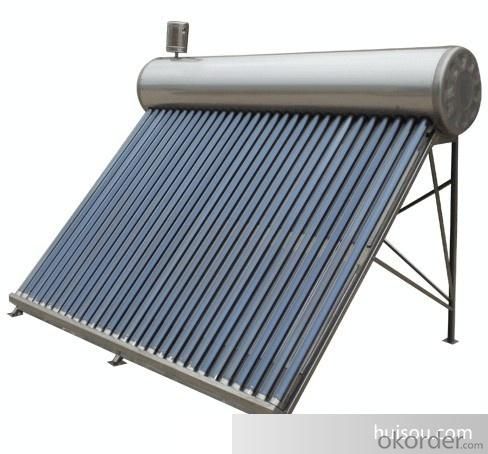
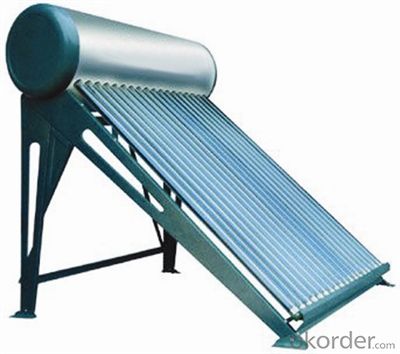
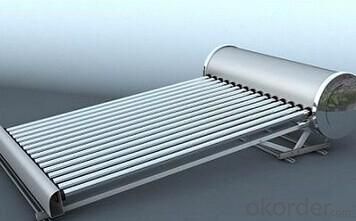
Our Services
1. OEM service
2. Warranty: 5 years
3. Considerable after sale service
Color steel Compact pressure Thermal solar heater
FAQ:
1. What’s the delivery time?
10 days after receiving deposit.
2. How long is the warranty?
5 years for whole system, 1 year for accessory
3. What’s your production capacity?
6000sets/month
4. What’s the MOQ?
1 set.
5. What’s your payment term?
Container: 30% T/T in advance for deposit, 70% T/T before shipment for fist order.
70% T/T after seeing copy of B/L from second order
Sample: 100% T/T in advance
Other choices: L/C at sight.
6. What certifications do you have?
CE, SOLAR KEYMARK, SRCC and etc.
- Q:Can solar collectors be used for drying household appliances?
- Using solar collectors for drying household appliances is not possible. Solar collectors are specifically designed to capture sunlight and convert it into heat energy. This heat energy can be utilized for heating water or generating electricity. However, it is not effective for drying household appliances as the temperature produced by solar collectors is generally not sufficient for this purpose. To efficiently dry clothes or other items, household appliances like clothes dryers require a much higher temperature and specific airflow. Therefore, alternative methods like air drying or using specialized drying appliances would be more appropriate for drying household appliances.
- Q:Can solar collectors be used in agricultural applications?
- Yes, solar collectors can be used in agricultural applications. They can be utilized to power irrigation systems, provide heat for greenhouses, or generate electricity for various farming operations. Solar energy offers a sustainable and cost-effective alternative to traditional energy sources in agriculture, promoting the use of renewable resources and reducing carbon emissions.
- Q:Are solar collectors suitable for heating livestock buildings?
- Yes, solar collectors are suitable for heating livestock buildings. They can effectively harness the sun's energy to provide sustainable and cost-effective heating solutions for livestock buildings, helping to maintain optimal temperature and comfort for the animals. Additionally, solar collectors can contribute to reducing greenhouse gas emissions and energy costs associated with traditional heating methods.
- Q:Can solar collectors be used for heating electronics manufacturing plants?
- Yes, solar collectors can be used for heating electronics manufacturing plants. Solar thermal systems can be integrated into the heating systems of these plants to provide a renewable and sustainable source of heat. This can help reduce the reliance on fossil fuels and decrease the carbon footprint of the manufacturing process.
- Q:How do solar collectors compare to other forms of renewable energy?
- Solar collectors are often considered one of the most efficient and widely available forms of renewable energy. They have several advantages over other renewables, such as wind or hydroelectric power. Solar collectors can be installed in various locations, both residential and commercial, making them accessible to a broader range of users. Additionally, solar energy is abundant and inexhaustible, unlike some other forms of renewable energy. Furthermore, solar collectors have minimal environmental impact compared to, for example, hydropower, which can disrupt ecosystems. Overall, solar collectors offer a reliable and sustainable energy solution that is highly competitive with other forms of renewable energy.
- Q:Can solar collectors be used for generating electricity in forests?
- Yes, solar collectors can be used for generating electricity in forests. Solar collectors, specifically photovoltaic (PV) panels, are designed to convert sunlight into electricity. As long as there is sufficient sunlight reaching the forest floor, solar collectors can be installed to harness this energy and generate electricity. However, it is important to consider the density and height of the forest canopy, as excessive shading can significantly reduce the efficiency of solar collectors. In such cases, careful planning and positioning of the solar collectors may be necessary, such as placing them in clearings or areas with less shade. Additionally, regular maintenance and cleaning of the panels may be required, as fallen leaves, branches, or debris from the forest can accumulate and obstruct sunlight absorption. Overall, while solar collectors can be used in forests for electricity generation, the specific location and conditions of the forest need to be taken into account for optimal efficiency.
- Q:Can solar collectors be used for heating sewage treatment plants?
- Yes, solar collectors can be used for heating sewage treatment plants. Solar thermal energy can be harnessed through the use of solar collectors to heat water or other fluids, which can then be used to warm sewage in treatment plants. This renewable energy source can help reduce the reliance on fossil fuels and lower the overall energy consumption of sewage treatment plants.
- Q:Are solar collectors affected by hail or other severe weather conditions?
- Yes, solar collectors can be affected by hail or other severe weather conditions. Hail can cause physical damage to the collectors, such as cracks or dents on the surface, which can impair their performance. Other severe weather conditions like strong winds or heavy snowfall can also potentially damage or dislodge the collectors. However, proper design, installation, and use of protective measures can minimize the impact of these weather conditions on solar collectors.
- Q:How do solar collectors affect the environment?
- Solar collectors have a positive impact on the environment as they harness the sun's energy to generate electricity or heat without emitting harmful pollutants or greenhouse gases. By utilizing renewable energy, solar collectors help reduce our dependence on fossil fuels, which are major contributors to air pollution and climate change. Solar collectors also have a minimal impact on land use. They can be installed on rooftops, reducing the need for additional land or disrupting natural ecosystems. Additionally, solar collectors can be integrated into existing infrastructures, such as parking lots or agricultural fields, maximizing their efficiency and minimizing any negative effects on the environment. Another important aspect is the conservation of water. Traditional power generation methods, such as coal or natural gas, require significant amounts of water for cooling purposes. In contrast, solar collectors do not require water for operation, thereby conserving this valuable resource. The production of solar collectors does have some environmental implications, specifically related to the mining and manufacturing processes involved in producing the necessary materials. However, these impacts are considered relatively minimal compared to the long-term benefits of utilizing solar energy. Overall, solar collectors have a net positive impact on the environment by reducing greenhouse gas emissions, conserving water, and minimizing land use. They play a crucial role in transitioning towards a more sustainable and clean energy future.
- Q:Can solar collectors be used for heating residential care facilities?
- Yes, solar collectors can be used for heating residential care facilities. Solar thermal systems can efficiently capture and convert sunlight into heat energy, which can then be used for space heating and hot water in residential care facilities. This renewable energy source can help reduce heating costs and greenhouse gas emissions, making it an environmentally-friendly and sustainable solution for heating these facilities.
1. Manufacturer Overview |
|
|---|---|
| Location | |
| Year Established | |
| Annual Output Value | |
| Main Markets | |
| Company Certifications | |
2. Manufacturer Certificates |
|
|---|---|
| a) Certification Name | |
| Range | |
| Reference | |
| Validity Period | |
3. Manufacturer Capability |
|
|---|---|
| a)Trade Capacity | |
| Nearest Port | |
| Export Percentage | |
| No.of Employees in Trade Department | |
| Language Spoken: | |
| b)Factory Information | |
| Factory Size: | |
| No. of Production Lines | |
| Contract Manufacturing | |
| Product Price Range | |
Send your message to us
Non-Pressurized Heat Pipe with Copper Solar Water Heater System
- Loading Port:
- China main port
- Payment Terms:
- TT OR LC
- Min Order Qty:
- 1 set
- Supply Capability:
- 6000 set/month
OKorder Service Pledge
OKorder Financial Service
Similar products
New products
Hot products
Hot Searches
Related keywords
